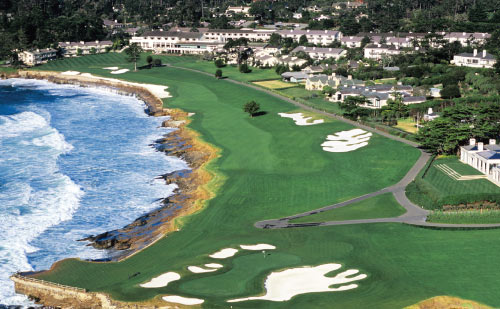
Neal Hotelling is director of licensing for Pebble Beach Company, but that doesn’t begin to cover the many hats he wears. Editor of Pebble Beach: The Magazine, book author, and an expert in local history and photographs, he just completed his third book, “Pebble Beach, The Official Golf History.” Current photographs are by noted golf course photographer Joann Dost. (See ICON story in print edition, page. 38.)
The book focuses on the famous courses and players that weave together a history of Pebble Beach, as well as on some of the lesser-known players and tournaments that touched the Peninsula.
“I really wanted to get the story out,” Hotelling says, “especially on the tournaments that nobody knows about.” Collaborating with Dost was a natural choice, as the two have put words and images in print many times before.
“Joann and I have worked together for many years,” Hotelling says. “She shot the 1982 U.S. Open book and has been working longer at Pebble Beach than I have.When the publisher of my first book was conceiving it, he decided he wanted to go with a single photographer for all the current photography, so it was a natural to stay with Joann for this book.”
One of Hotelling’s previous books, “Pebble Beach Golf Links: The Official History,” earned him the 1999 Golf Book of the Year award from the International Network of Golf. “[That] first book focused on Pebble Beach Golf Links and the influence that course has had over 10 years,” he says, “but one thing I didn’t have space for was the depth of the tournaments that have been here going back to the California State Amateur and the Crosby on multi-course venues. Pebble Beach Golf Links is the anchor, but the other courses are also part of the story: Del Monte, Poppy Hills, etc.”
While scouring archives, trophy cases and old tournament programs for information, Hotelling came across many inconsistencies in tournament data, which he double and triple checked by looking at old newspaper scans and photographs, and in some cases, calling the relatives of former tournament winners, including the son of World Golf Hall of Fame recipient Lawson Little. In many instances, Hotelling corrected errors and set the record straight for the Northern and Southern California Golf Associations.
“I went through literally thousands of documents,” he says. “Over 400 tournaments were played at Pebble Beach.”
Many of the images from the book come from the Pebble Beach archives, a handy source since Hotelling manages some estimated 40,000 images that Pebble Beach Company owns. He believes that the worldwide impact of the course makes the book of interest to many.
“It’s much more than a regional book,” he says. “Pebble Beach Golf Links, if not the most famous golf course in the world, is certainly right up there. Millions of people who have played from all over the world come here and the history is so rich. It’s one of the things that helps bring people here and being able to document that gives the book international appeal.”